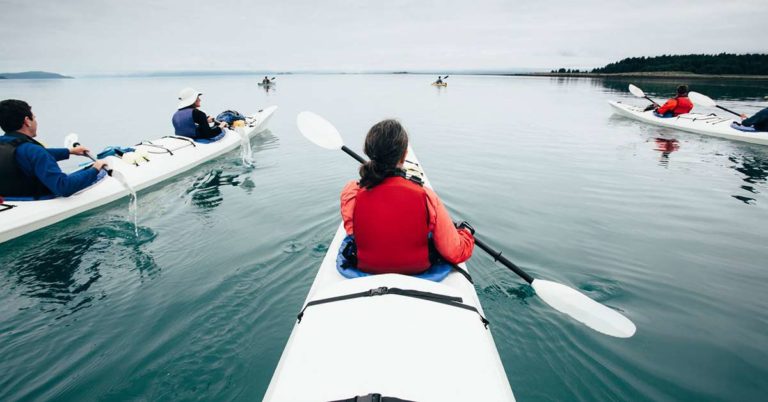How to Get Started with Kayaking
Kayaking can offer you an exciting or a relaxing experience depending on your location. If you’ve never been kayaking before, though, you might be understandably worried. You may have images of whitewater rapids racing through your mind. Do kayaks tip easily in such rapids?
Not all kayaks are created equal. Some are best suited for whitewater rapids while others are better suited for coasting along a lake. To help you get started with kayaking, we’ve created this handy guide on kayaking for beginners.
What Equipment Do You Need to Kayak?
There are a ton of different kayak accessories available. To kayak successfully, though, just a few basics are needed. At the bare minimum, get a kayak and a set of oars. The oars specifically used for kayaking are one piece with a long pole connecting the two fins that you use to steer yourself through the water. That’s all you’ll require to get started kayaking.
However, for safety, consider getting both a life jacket and a helmet. The latter is especially important if you intend to go whitewater rafting. Should you fall from the kayak, the helmet can keep your head protected from rocks and boulders in the water.
You might also want to get a kayak rack for your car. If you intend to own a kayak, transporting it is important. There are inflatable kayaks, but these aren’t always the best quality. A rack can help you transport your kayak safely.
What is the Best Type of Kayak for a Beginner?
Before you order or purchase you first kayak, ask yourself what you’re using it for. Are you a fan of canoeing and you just want to use the kayak to traverse slowly through calm waters? If so, you may be more interested in kayaks that are shorter but not too durable. Do you want to race your kayak? You may wish to get a longer kayak that is narrow and made of a smooth material. Do you want to go whitewater kayaking? It’s important to focus on durability in this case.
Kayak Stability
If you are hoping for a gentle experience with your kayak, focus solely on its stability. Shorter kayaks provide better stability. What type of kayak is best for lakes? A short kayak is the answer here. You’ll be faced with a few waves, so stability is crucial.
It isn’t a bad idea to choose a material such as hard plastic for durability, either. For calmer lakes, however, you can get away with fiberglass kayaks and inflatable kayaks.
Kayak Depth
Depth is also an important factor for beginners to consider. The deeper the kayak is, the more storage you’ll have inside of it. However, beginners may be a little wary about fitting inside the kayak in case it tips over. Kayaks known as “sit-ons” offer little depth.
A shallower kayak makes it easier to get in and out of it. It also means that if you tip over, you’ll find yourself going into the water instead of being trapped in the kayak. However, you sacrifice that storage space with a sit-on.
Kayak Width
Width also plays a factor with those just beginning their kayaking journey. Wider kayaks are more stable. However, their turn radius is slower. If you want to use your kayak for whitewater activities and racing, choose one that has a narrower body. That turning radius is going to be important in dodging boulders and other racers.
If you’re just planning on using your kayak leisurely, select a wider kayak. The turning radius won’t impact you as much.
Getting in and out of a Kayak
Kayaking itself is quite easy once you’re out on the water. Perhaps the most difficult challenge is getting in and out of the kayak. It’s easier when you have someone help you. If you’re on a shore, then you can just step into the kayak and have someone push you into the water. If you’re by yourself, try to use your hands to push on the ground and lift yourself and the kayak into the water. You can also try to use your oars, but be wary of breaking them if you push too hard.
If you’re on a dock, it’s best to have someone around to hold the kayak while you step into it. If no one is there to help, you can tie your kayak securely to the dock. Once you step inside, you can undo the fastenings and push away from the dock.
In terms of getting out of the kayak, it’s important to go fast when heading to shore. Oar yourself fast and hard toward the shoreline to give yourself as much velocity as possible to skate along the shore. Again, having another person there to help pull the kayak further up the shore is helpful.
For dock parking, don’t worry about going fast. Instead, tie yourself to the dock and carefully stand on the kayak. Then climb onto the dock. You may wish to invest in a dock ladder to make this a little easier.
Kayak Care
It’s critical to take care of your kayak to increase its durability. Cleaning it is a vital part of this process. Certain bacteria and algae in the water can eat away at the material throughout time.
Storage is also important when you’re beginning to learn to kayak. Kayaks should be stored in a cool place out of the sun. They’re best kept hung rather than stacked to prevent warping and dents.
At StorageMart, we have climate controlled units where you can store your kayak safely. Check out our storage unit size guide to find the ideal setup for you, or contact us to rent a unit today or get more information!
Updated February 10, 2020


